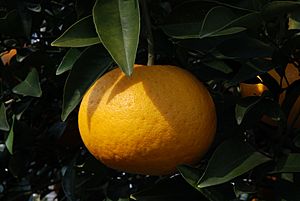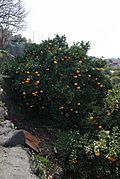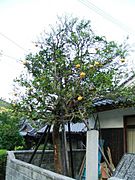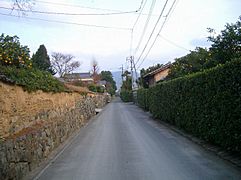Amanatsu facts for kids
Quick facts for kids Natsumikan / Amanatsu |
|
|---|---|
 |
|
| Scientific classification | |
| Kingdom: | |
| (unranked): | |
| (unranked): | |
| (unranked): | |
| Order: | |
| Family: | |
| Genus: | |
| Species: |
C. × natsudaidai
|
| Binomial name | |
| Citrus × natsudaidai Hayata
|
|
The Amanatsu or natsumikan is a special kind of citrus fruit. It's a yellowish-orange fruit that looks a bit like a grapefruit. This fruit was first discovered in 1740 in the Yamaguchi Prefecture of Japan. It's a cultivar, which means it's a plant grown for its specific traits, and it's a hybrid of different citrus plants.
Contents
What's in a Name?
The name Amanatsu means "sweet summer" in Japanese. In Japan, people also call this fruit by other names. These include kawano natsu daidai (カワノナツダイダイ(川野夏橙)), amanatsu daidai (甘夏橙), amanatsukan (甘夏柑), and amanatsu mikan (甘夏蜜柑(甘夏みかん)).
All About the Amanatsu Fruit
The natsumikan fruit is usually about the same size as a grapefruit. It has a slightly flattened, round shape. Inside, you'll find about 12 sections and around 30 seeds. The skin of the fruit has a rough texture, but it's quite easy to peel.
How People Enjoy Amanatsu
People often eat natsumikan fresh, just like an orange. It's also used to make many different products. You might find it in marmalade, which is a type of fruit preserve. It's also used to make alcoholic drinks.
Where Amanatsu Grows
Natsumikan is grown for sale in Japan. The main areas where it grows are Yamaguchi Prefecture, Kumamoto Prefecture, and Ehime Prefecture. The city of Hagi is especially famous for its natsumikans. They use them to make delicious natsumikan juice and ice cream.
A Special Orange Touch
The Yamaguchi Prefecture is very proud of its natsumikan industry. So much so that they even changed the color of their road crash barriers! Instead of the usual white, you'll see bright orange barriers there. This is a special tribute to their famous fruit.
The Family Tree of Amanatsu
Scientists believe that the natsumikan tree comes from the pomelo. The pomelo is a very large citrus fruit, known scientifically as Citrus grandis or Citrus maxima. This means the natsumikan shares some of its genetic background with the pomelo.
Amanatsu and Health Research
Researchers have studied the immature peel of the natsumikan. They found that it might be helpful for treating long-lasting allergic skin problems in mice. This research shows that parts of the natsumikan could have health benefits.
Gallery
See also
 In Spanish: Amanatsu para niños
In Spanish: Amanatsu para niños








